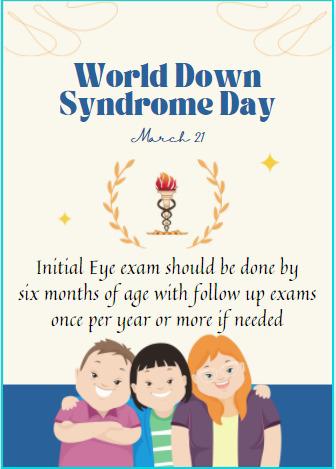1647859162054.png)
World Down Syndrome Day (WDSD) is on March 21st every year.
Around the world, people with Down syndrome face barriers to inclusion on a daily basis. Often these barriers are the result of a misunderstanding about Down syndrome and the vital role those with Down syndrome play within their families and communities.
This year, we invite everyone to raise awareness about the challenges faced by those with Down syndrome and advocating for the full inclusion of people with Down syndrome in our society.
Eye disorders in children with Down syndrome:
Children with Down syndrome are at increased risk for a variety of eye and vision disorders. Fortunately, many of these eye problems can be treated, especially if discovered at an early age. The quality of life can be further enhanced by the proper assessment and correction of eye problems.
The most common eye findings include:
1. Refractive errors - Children with Down syndrome are more likely to need glasses than are other children
2. Squint - Between 20% and 60% of individuals with Down syndrome have eyes that are misaligned (strabismus). Squint/Strabismus may be treated with glasses, patching, and/or eye muscle surgery.
3. Keratoconus - A cone shaped distortion of the cornea (front layer of the eye), occurs in up to 30% of those with Down syndrome. Keratoconus is usually diagnosed around puberty and should be monitored regularly.. Keratoconus is worsened by eye rubbing; therefore, eye rubbing should be discouraged.
4. Cataract - There is an increased incidence of congenital cataracts (present at birth) as well
